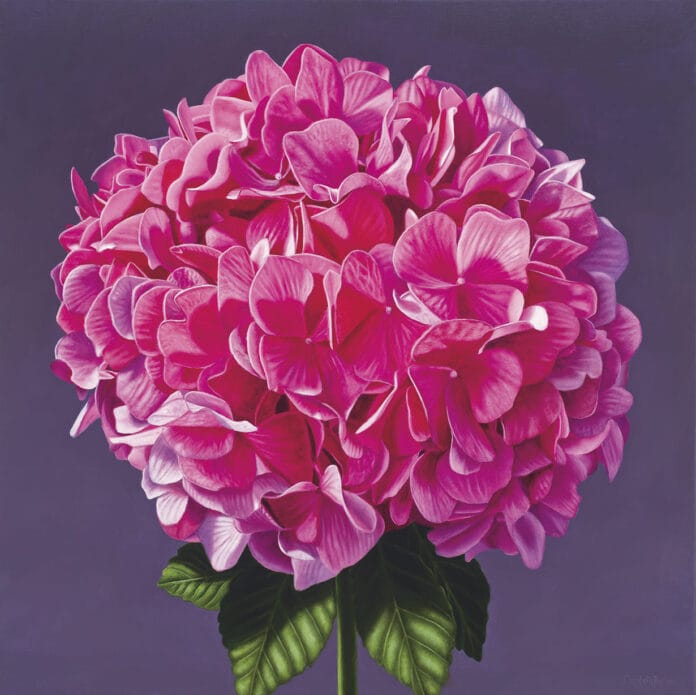In Elizabeth Barlow’s oil painting Jane’s Hydrangea, a single bloom becomes a portal—one that opens gently into memory, loss, and renewal. This composition, rendered with meditative precision, was created as a private commission honoring a woman whose life was deeply intertwined with her garden. Jane, the collector’s late wife, was known for cultivating hydrangeas in rare and unexpected colors. Barlow’s painting captures this spirit of uniqueness and devotion, offering a floral portrait not only of a bloom, but of a love that endures through nature.
A Bloom for Jane
At first glance, the painting is striking for its stillness. A solitary hydrangea, full and luminous, seems to emerge from the linen surface as if lit from within. Its subtle tones—soft violets, dusty blues, and blushes of fading pink—evoke a quiet emotion, both mournful and life-affirming. It is neither overly sentimental nor distant. Instead, the flower stands as witness to a life and relationship now carried on through memory.
Commissioned by Jane’s husband, the painting serves as a tribute to a woman who found great joy in coaxing beauty from the soil. For Barlow, the work became more than a portrait—it was a meditation on grief, healing, and the cycles of transformation that flowers so often mirror. In Jane’s Hydrangea, nature is not decorative. It is sacred.
The Language of Flowers
Barlow’s current body of work, titled Flora Portraits, began with a similar act of commemoration. In 2016, she was commissioned to paint a rose bush—the lone survivor of a California wildfire that had otherwise destroyed everything in its path. That rose, blooming defiantly among ashes, awakened something in the artist. It was more than a subject. It was a symbol.
“I began to see flowers as portraits,” Barlow has said. “Each one carries a personality, a history, a meaning.” In the years since, she has devoted herself to this idea, capturing individual blooms with the reverence one might give to a face or a memory.
Barlow’s hydrangea, in this light, is not just a flower. It is Jane herself—resilient, graceful, and deeply connected to the world around her.
A Life Rooted in Nature
Elizabeth Barlow’s sensitivity to flowers was cultivated long before she painted them. She was raised in a home surrounded by gardens designed and tended by her mother. Her father, Philip Barlow, was a painter who instilled in her an appreciation for art and the discipline it requires.
After completing her studies in San Francisco, Barlow established her first studio in the city and began refining her style—a synthesis of classical realism, contemporary sensibility, and emotional resonance. Her move to Carmel-by-the-Sea on California’s coast marked a turning point. Surrounded by the coastal flora and working from a studio inside a historic church, Barlow found the space to deepen her exploration of botanical subjects. Her window looks onto a blooming garden—both muse and metaphor.
Emotional Realism in Botanical Form
Technically, Barlow’s oil paintings are exercises in discipline. She works slowly, layering glazes and building depth through detail. Yet despite their precision, her works never feel cold. There is a quiet intimacy in the way she paints—a tenderness that reflects her intention to capture more than just physical likeness.
In Jane’s Hydrangea, this is particularly evident. The soft folds of the petals, the subtle play of light and shadow, the way the bloom seems to hover in space—all contribute to a sense of presence. The flower is not frozen in time. It breathes.
Barlow refers to her floral paintings as “portraits” with purpose. Like a good portrait, they tell stories. They carry the emotional weight of the person or moment they represent. In this way, each flower becomes a vessel.
Represented and Recognized
Elizabeth Barlow is represented by Andra Norris Gallery in the San Francisco Bay Area, where her Flora Portraits have found a growing audience. Her work is held in private and public collections across the country. Collectors are often drawn to the emotional depth of her work—paintings that seem to speak without words.
Whether commissioned or self-directed, her practice remains rooted in the same philosophy: that beauty, memory, and meaning can be found in the natural world, if we are willing to look closely.
A Living Memory
Jane’s Hydrangea stands as a lasting tribute to a beloved woman and her garden. It is also an invitation—a quiet urging to slow down, to notice, and to remember. In this single bloom, Barlow has not only captured a likeness. She has captured a legacy.
The painting lives now in a private collection, but its story reaches beyond the walls where it hangs. It reminds us that even in grief, beauty can be found. Even in stillness, life goes on.


